Sign up for The Wild
We’ll help you find the best places to hike, bike and run, as well as the perfect silent spots for meditation and yoga.
You may occasionally receive promotional content from the Los Angeles Times.
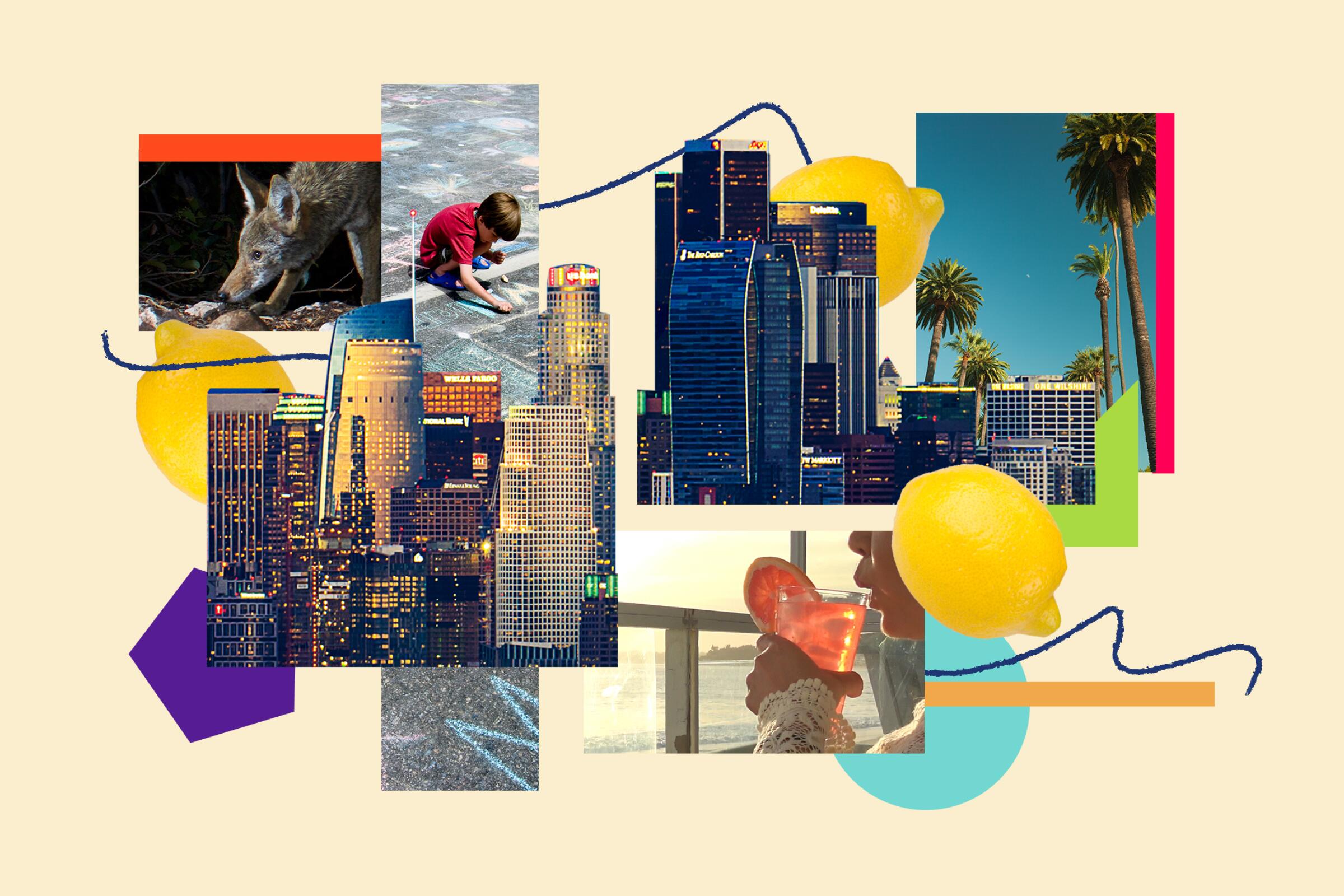
There’s no sugarcoating it: The coronavirus pandemic, along with the unprecedented measures being taken to slow its spread, have upended our lives, affected our livelihoods and profoundly altered the look and feel of our communities in once unimaginable ways. Even more unimaginable, perhaps, is that anything good could come from all of it.
But those who live in Los Angeles, which has been under a “safer at home” order since mid-March, have seen many things that define the downside of L.A. living — including the sprawling geography, traffic, smog and insular social interaction — shift, morph or disappear as hacks, tweaks and workarounds are deployed to keep essential businesses open and millions of residents safe.
o highlight the silver lining in this grayest of gray clouds, we’ve compiled a dozen positive — and L.A.-centric — things we’ve found ourselves enjoying over the last two months and that we hope will continue long after the threat of the coronavirus is in the rearview mirror.
After the trails and golf courses closed in Griffith Park, I was stuck power-walking the flat horse trails between the Autry Museum of the American West and the ranger station on Crystal Springs Drive.
I rounded a corner on the wide dirt tail early one morning and saw four coyotes dancing, jumping, rolling on their backs and nipping at one another on one of the park’s golf courses. They looked healthy in their fur coats. Maybe they do this every morning, but these big canines acted like they owned the place.
I continued my walk and noticed that smaller birds, like juncos and white-crowned sparrows, didn’t scatter so quickly when I approached. A few days later, I saw a great blue heron walking down a city sidewalk.
— Mary Forgione
Staying home this weekend? We’ve got some ideas. Take care of your plants, make your house cozier, help neighbors and start planning your next trip.
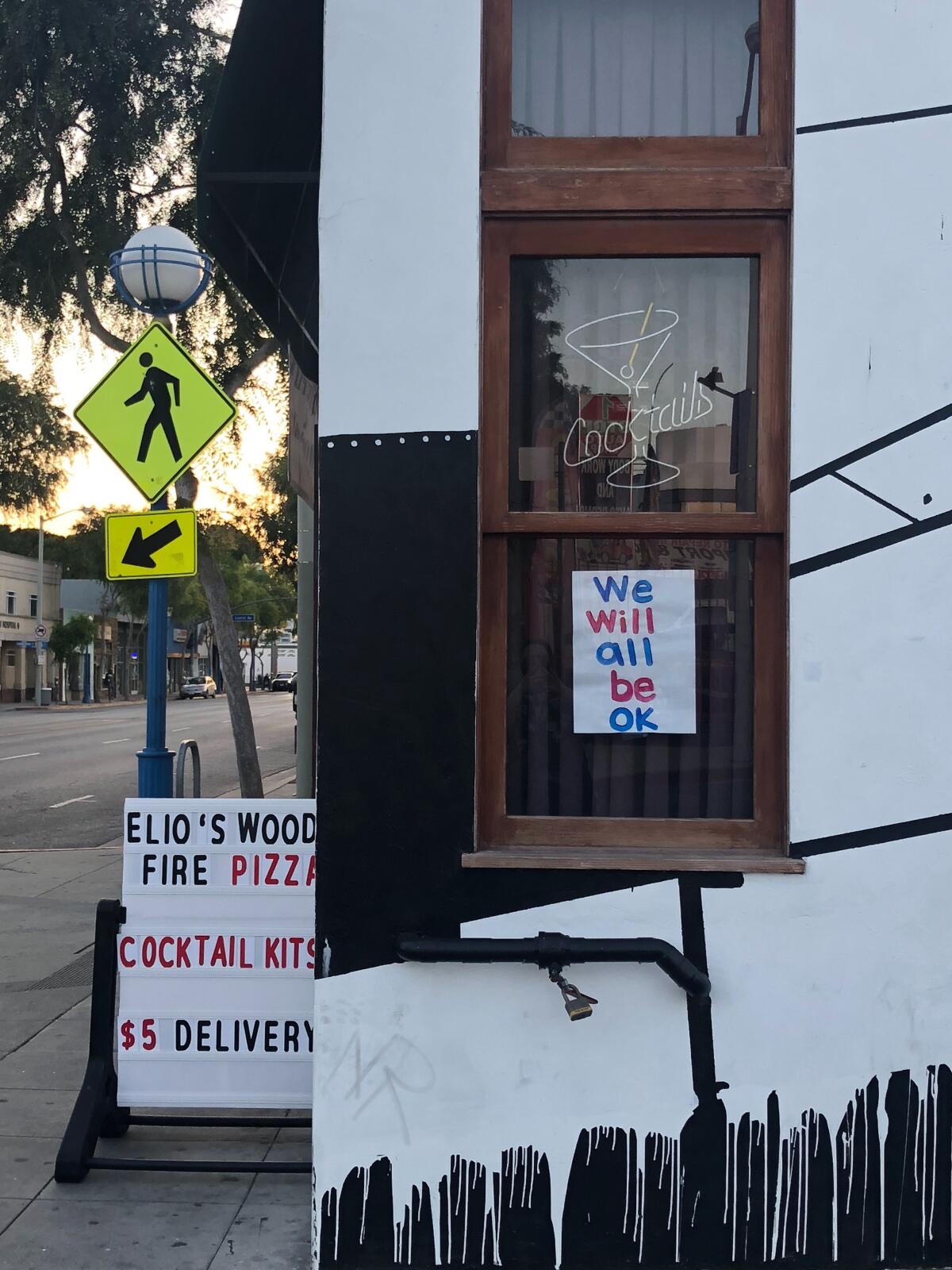
L.A.’s food-obsessed diners know the truth: Great food tastes even greater with a cold drink in your hand. So when this is over, why not find a way to keep takeout drinks legal?
This change just makes sense: You get your sushi and the crisp, ice-cold Sapporo that pairs perfectly with it. Or your pasta with the house-made sangria. Or your tacos with premixed margaritas (just add ice). Our gigantic (though by no means complete) list of places around Southern California offering takeout and delivery has plenty of options.
Frankly, I’m not sure why we weren’t doing this before the coronavirus pandemic. I’m sure the answer has something to do with liquor licenses and municipal codes. But I’m not aware of any evidence that the proliferation of premade cocktails in soup containers has led to any meaningful increase in crime.
Telling restaurants they can sell alcohol, but only if customers stay on the premises to drink it, feels downright Puritan. It’s a new age. Time to let the old ways die. Free the booze!
— Jessica Roy
L.A. takeout and delivery options to mark special occasions during the shutdown
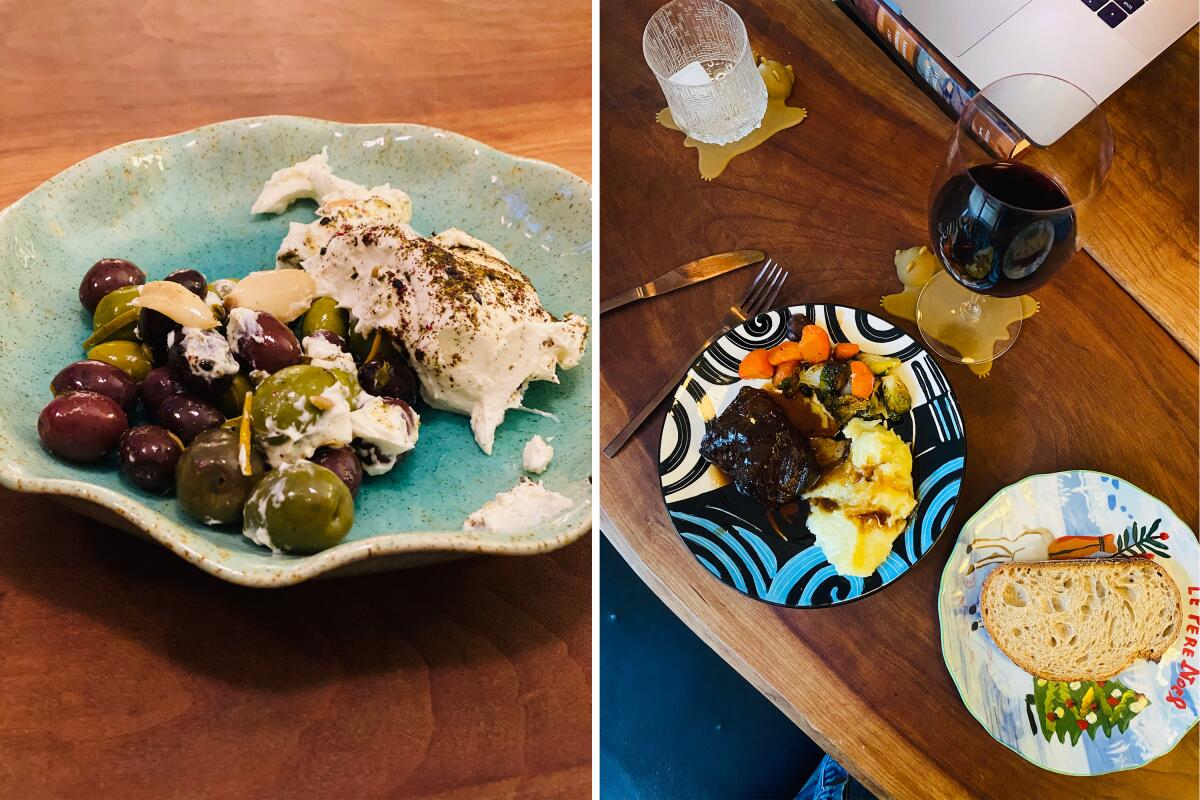
In the last six weeks, I’ve eaten coursed-out meals from Felix, Bestia, Bavel, Broken Spanish, Pasjoli and Dialogue. I’ve had beef bourguignon with mashed potatoes, rigatoni all’amatriciana, hummus and butter bean masabacha and half a duck for two, burnt Basque cheesecake and so many more tasty treats. And I ate this all at home. At my table. With my own bottle of wine. My partner by my side and two L.A. friends staring back at me on the computer.
Each week, the four of us pick a restaurant and coordinate our pickup times for Saturday evenings. We swing by the restaurants around 6 (thank you, no traffic), head back to our own kitchens, follow the reheating instructions provided by the restaurants and open up our laptops for a feast. It’s the best part of my week. So to the delicious restaurants, I say: While I very much want you to open and be full of humans, please leave us the option to re-create the experience in our own homes. Please continue to offer complete meals to-go. It feels nice and special to plate your farm cheese and marinated olives, to reheat your sourdough in my 375-degree oven. I promise I’ll still come see you, but there’s just something so nice about staying in sometimes.
— Amy King

It’s not that I hated my neighborhood, but like others who are transplants to L.A., I was indifferent. After two decades in the same place, I didn’t appear to be getting over it any time soon.
Then came the miracle of cabbage, potatoes and an unexpected, undeserved kindness.
Just as my family traditions require turkey at Thanksgiving, St. Patrick’s Day means corned beef, cabbage and potatoes. The meat was easy to find, but the rest eluded me, despite trips to various groceries.
My last resort: the corner market, where I’d stopped over the years but always found inhospitable. It was under new ownership, so why not try?
I entered and glanced left. Jackpot! Potatoes and cabbage. I hugged them close, like long-lost relatives. At checkout, the guy behind the counter, who was the new owner, welcomed me and said he was glad to try to get anything I needed — even toilet paper.
He bagged my newfound riches, wished me a good day and gave me his business card, sending me off with a sense of a community that, after 20 years, finally and now forever feels like home.
— Catharine Hamm
Get our Cooking newsletter.
Your roundup of inspiring recipes and kitchen tricks.
You may occasionally receive promotional content from the Los Angeles Times.
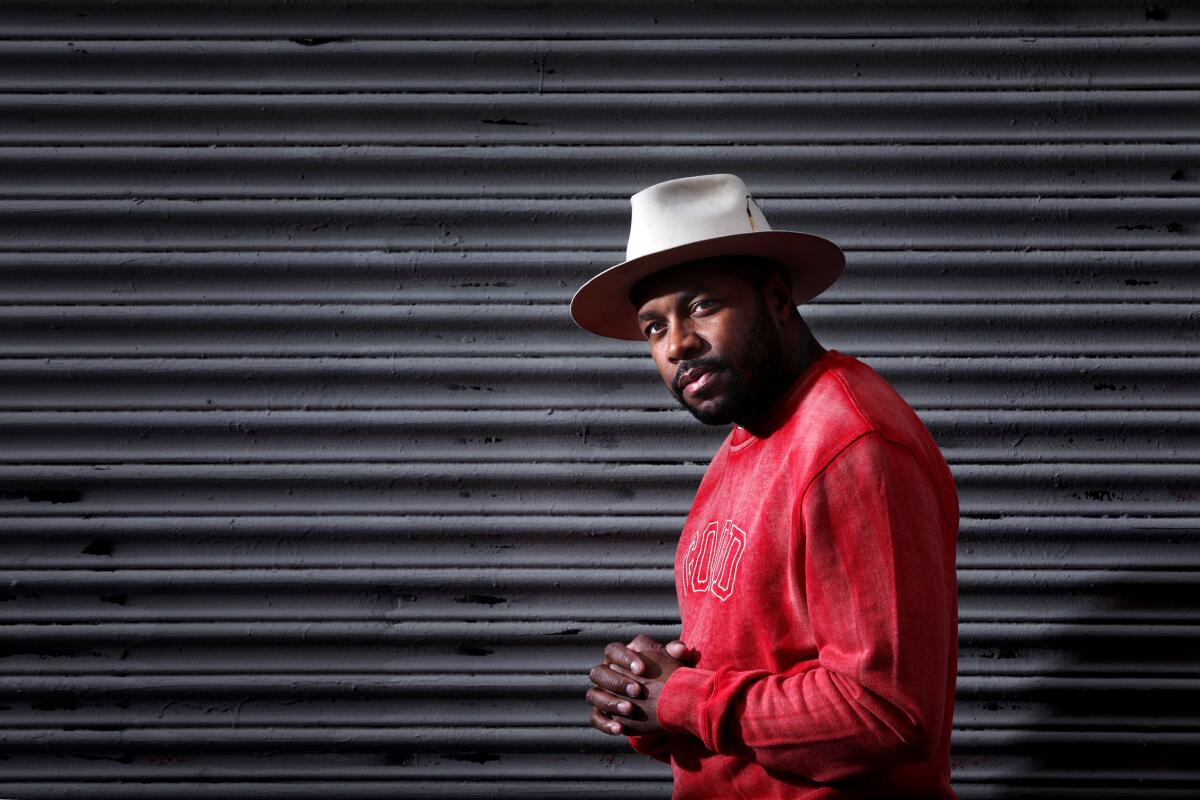
During a weekend in March, I came across DJ D-Nice, a breakout star of the coronavirus era. I had read about him in an Instagram post by “CBS This Morning” anchor Gayle King and was looking for something to brighten my mood. After jumping over to his Instagram Live session, I spent two hours dancing nonstop as part of an at-home workout.
D-Nice’s Club Quarantine isn’t exactly a physical nightclub or a flashy production. From his high-rise apartment in downtown L.A., he spins disco, funk, R&B and hip-hop classics. He also has a catchphrase, “Let it breathe.”
That’s when Gladys Knight, Prince, Al Green, Anita Baker, Mavis Staples, Stevie Wonder, Solange and others get another turn in the spotlight.
Club Quarantine has its regulars, including actor and singer Donnie Wahlberg. Seeing who drops by is as intriguing as the musical selections. The list includes former First Lady Michelle Obama, Queen Latifah, Will Smith, Mariah Carey, Halle Berry, Tracee Ellis Ross, Lionel Richie, Naomi Campbell, Lenny Kravitz, Ava DuVernay, Rihanna, Oprah Winfrey and Taraji P. Henson.
D-Nice started his at-home spinning spontaneously. “I was just sitting here in quarantine, missing my family and friends,” he told The Times in March. I’m just thankful he did what he knows best.
— Marques Harper
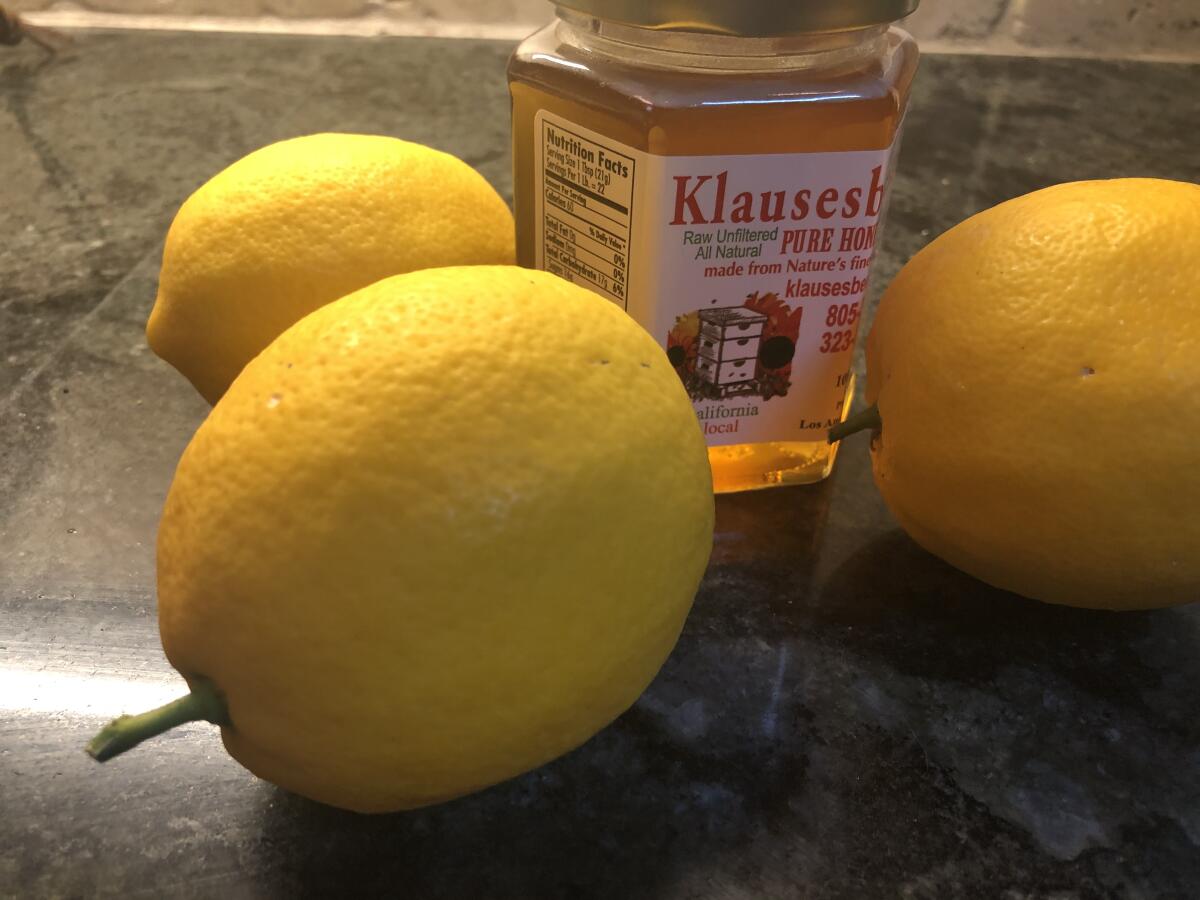
Someone gifted us a bag of lemons. So my son sliced the lemons into a glass glowing with ice and sugar, then poured in tea. Lately, it’s the little things.
We don’t even know who dropped the lemons on the porch, in the handsome Aveda bag. They were giant, and there was a moment when I wasn’t sure whether they were grapefruit; that’s how large they were. A California lemon, right off the tree, is like a bucketful of sunshine.
John and Kathy dropped off sourdough bread with a jar of honey. Alex and Margaret dropped off Korean barbecue. There have been soups and cookies out of nowhere. Yesterday, my neighbor Partha gave me Scotch.
I reciprocate with cut flowers from the farmers market, so fresh they come with butterflies and bees.
How nice if this continues! How nice if random gifts become something Americans are known for, if Swedes visiting here take note and think: “These Americans, they’re weird with all these gifts.”
Yeah, we are. And maybe we’ll always be.
— Chris Erskine
We asked readers to share acts of kindness, large and small, that they’ve witnessed during this time of coronavirus. They are different, but all spring from selflessness and elicit gratitude.
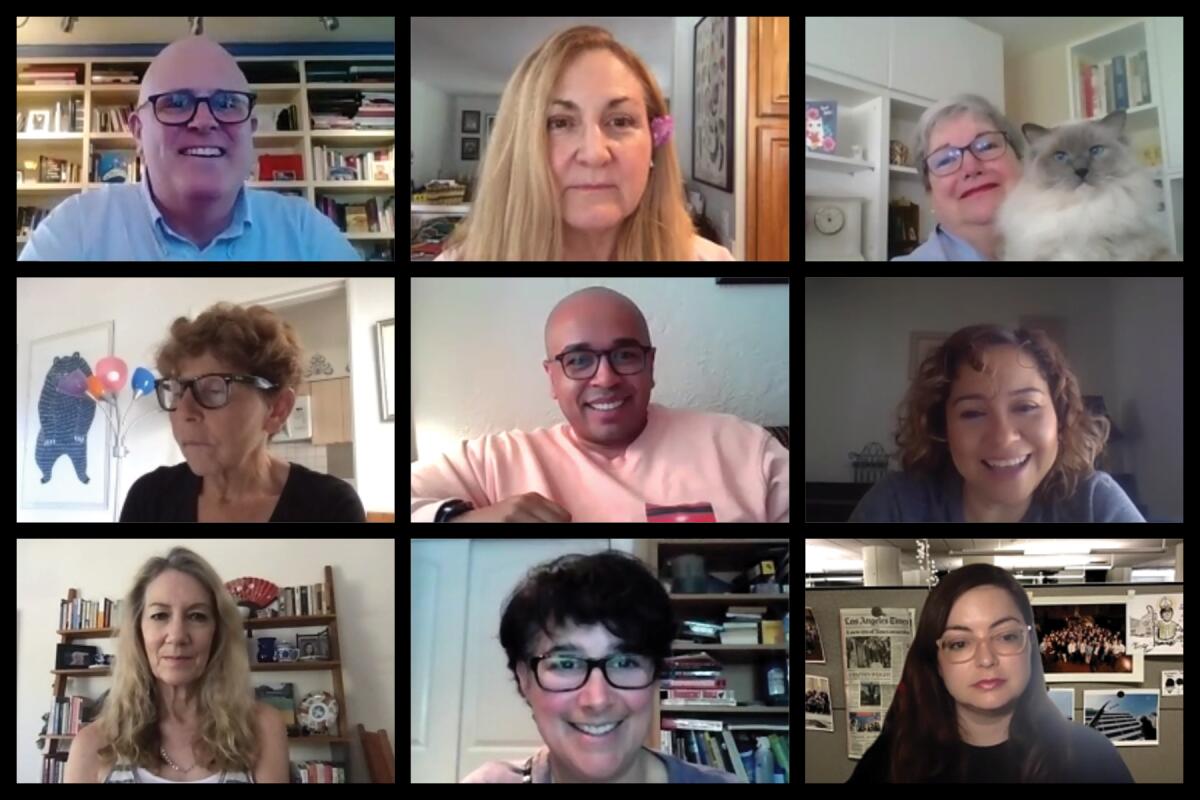
I didn’t realize how insular L.A. life was — and how little I knew about the people I work with — until the coronavirus pandemic gave me tiny glimpses into their out-of-office lives.
Los Angeles has always felt like a city predisposed to a certain kind of social distancing. Thanks to sprawling geography and legendary traffic that make visiting even the dearest friend on the far side of the 405 like driving to Hoboken, the chances of visiting a co-worker (even one you get along with swimmingly) in your downtime are close to nil. So it’s not surprising that I haven’t been in the homes of any of my co-workers in the decade-plus years we’ve known each other.
But recently, thanks to the from-home video-conferencing we’ve all adopted, I know what kinds of pillows cover their couches, what kind of artwork adorns their walls, what time of day the light streams most brightly through their windows and the peculiarities of how they fill their bookshelves. At times, that insight feels intimate, almost voyeuristic, and the act of being beamed into their homes while they’re being beamed into mine profoundly changes the way we perceive each other — and I think for the better.
As the disease curve flattens and more of us return to our physical places of work, these moments will likely become less frequent, but I wish they wouldn’t.
— Adam Tschorn
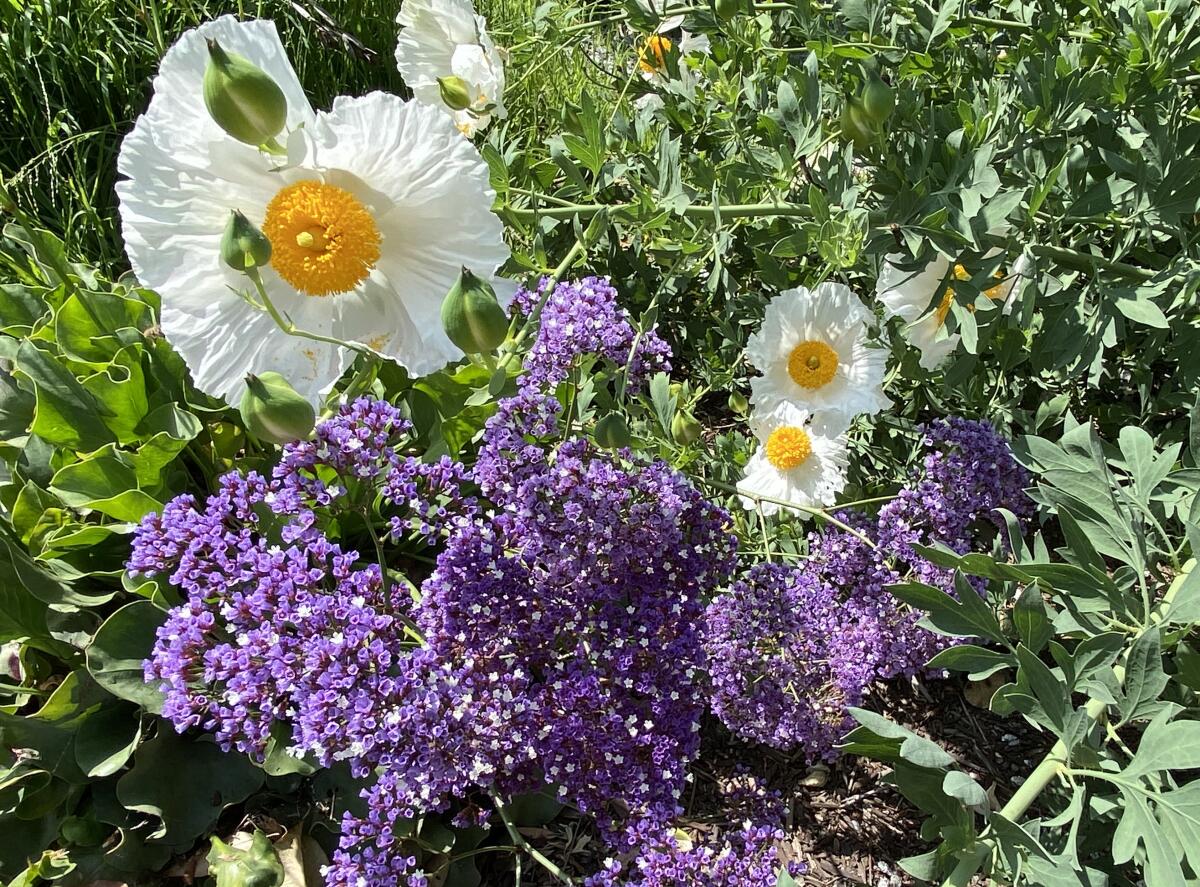
It might sound strange, considering we’re sheltering at home and keeping our distance, but I hope we can maintain the spontaneous camaraderie I’ve had with strangers these last six weeks.
On phone calls with people I’ve never met, every conversation just naturally begins with a checking in, a few minutes to talk about how we’re doing and the strangeness of it all before we get down to the business at hand.
That checking in extends to my suburban neighborhood, where pre-COVID-19 it was rare to see anyone outside, even my neighbors. Our front yards were mostly reserved for cars driving in and out of garages and gardeners who came by every week with their mowers and blowers. But in the last several weeks, our wide, quiet street has been busy with walkers, little family swarms with masked children on scooters or trikes, young teens talking earnestly as they stride by, an older couple waiting to stroll in the twilight.
More people are out in their front yards too, as though by seeing each other we can somehow connect, even at a distance. I’ve discovered neighbors we didn’t know we had, and if I’m in my yard, everyone says something as they pass, about a new flower or plant, or just the general pleasure of being outside. We look forward to watching our little parade of neighbors every day, and it’s made me more attentive to my garden, because it feels like a way to give back.
In the bleakness of our isolation, these little encounters are tiny comforts and a crucial reminder of how much we need each other to stay whole and sane.
— Jeanette Marantos
It’s time to stop wringing your hands over COVID-19: Plant some food and create your own victory garden. Here are eight steps to get started.
The powerful spring rainstorms are over, but the rainbows continue.
For chalk elves have taken to the streets, leaving their whimsical drawings and upbeat messages on the concrete paths that connect us to the outside world.
In some cases, the colorful sketches are an opportunity to express anonymous gratitude to essential workers.
“Thank you delivery people. You are heroes,” someone scribbled in Silver Lake.
Others use the sidewalks as a way to offer encouragement to neighbors and friends who may be anxious and struggling.
“Stay Strong,” was the dedication in Long Beach. “We can get through this.”
My friend Vicki Rank doesn’t have a sidewalk, so she hung a sign on the gate of her Mt. Washington home and invited people to “Draw your hearts out.”
The gate has since become an uplifting message board for the neighborhood.
Among the inscriptions: “Listen to the birds.” “Love is your birthright” and “It will pass.”
“It’s been really fun to watch them from my window,” Rank said of the chalk artists. “Kids get out of their strollers to draw. People stop and get off their bikes and out of their cars to write something. It’s so nice to hear people shout ‘Thank you’ from the street.”
If I had to choose an indelible theme for the COVID-19 chalk art I’ve seen, I would have to steal from one of the tags on Rank’s gate: “Practice kindness.” It’s a sentiment I hope continues long after the quarantine has ended.
— Lisa Boone
My neighborhood park is Heartwell Park in Long Beach. It’s mostly known as a home to youth sports, such as soccer, baseball, baseball and roller hockey. Spring and summer find these fields and courts spilling over with kids wearing cleats or carrying skates, and their families trailing behind. And the bike path running the length of the park usually sees light but steady traffic. The rest of the landscaped park? It gets very little use except for big holidays, such as Easter, and on special occasions when extended families need a shady place to gather and, apparently, leave their litter. (Who leaves balled-up dirty diapers along the curb?)
Since COVID-19, though, something has changed: All the youth sports are gone. The park was closed for Easter. But in many ways, the rest of the park is being used like never before: This past weekend, the bike path was bustling with cyclists, walkers and joggers — seemingly all following social distancing protocols. Families and couples gathered to play beneath the shady trees. Dogs frolicked (mostly on leashes). There were plenty of ducks and geese feeding at the small pond off Bellflower and Carson boulevards. Those healthy types were making their way through the park’s fitness courses, all wearing gloves. Best of all? No trash that I could see, and I was looking.
Heartwell Park is often overshadowed by the sprawling El Dorado East Regional Park and its nature center less than three miles away. Heartwell is sneered at for being so close to the whine of cars on Carson, while some parts of El Dorado Park feel completely isolated. But Heartwell Park’s busy interface is part of the charm, a reminder that we’re all in this together. Let’s just remember to find a trash can, OK?
— Rene Lynch
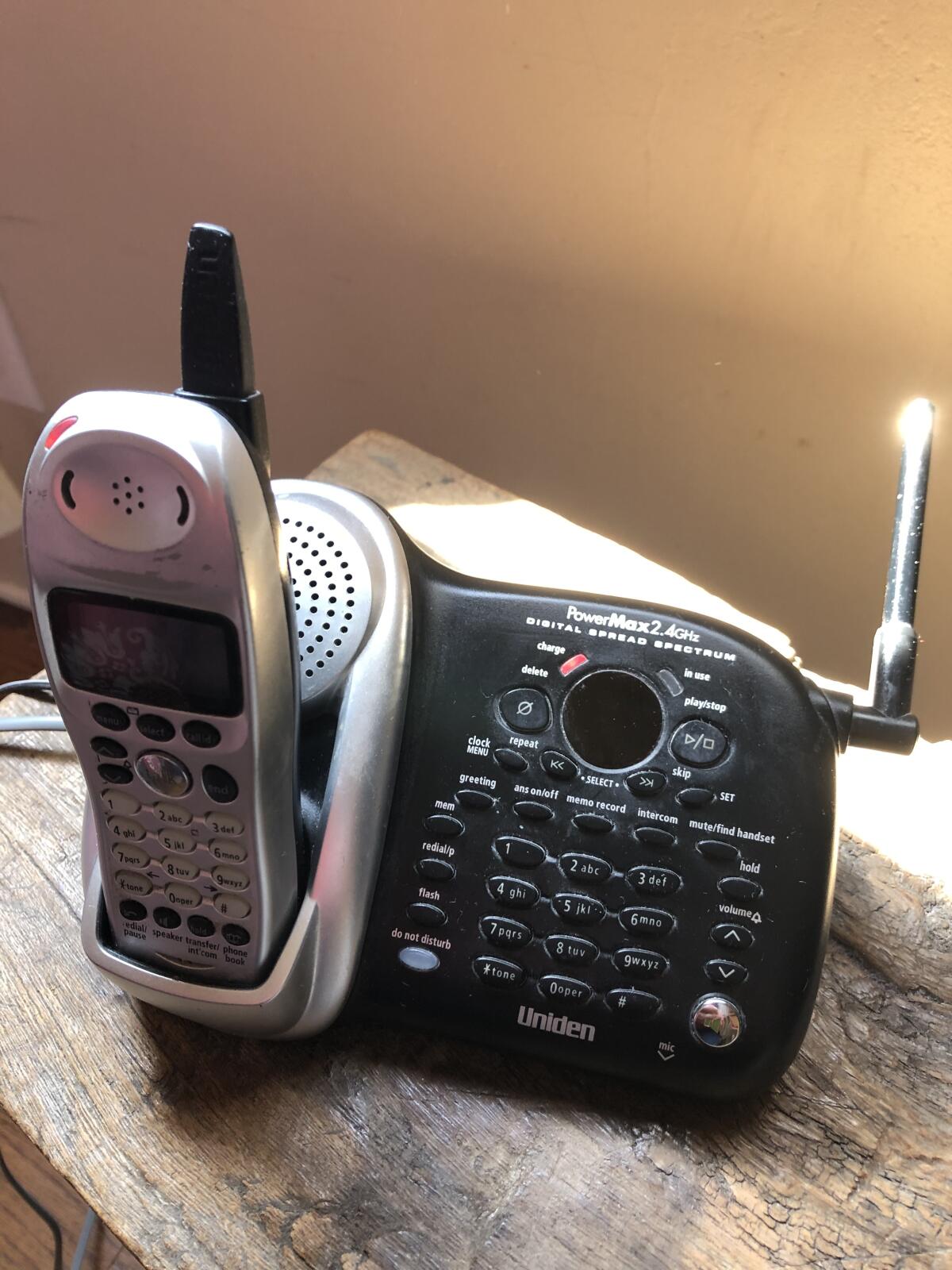
During this odd time at home, I’ve come to enjoy my morning walks, the bird songs and the voices of the neighbor kids as they play. But what I appreciate the most are the old-fashioned telephone conversations with friends, family and even an office colleague or two.
Because I no longer waste two hours or more a day commuting on L.A.’s freeways, I have put that newly liberated time to use by talking, not texting, emailing or even Zooming (unless required for work). I find comfort and connection in the booming voice of a friend I’ve known since nursery school or in the hoarse rumblings of a sibling recovering from cancer.
Our subjects are often mundane — the offer of a Costco run — but sometimes momentous — the loss of a job and the trials of filing for unemployment. Still, I relish the opportunity to sit and really talk, and listen too, about what is going on in our stay-at-home lives.
At some point, Los Angeles will head back to the office, the freeways will be jammed, and I will sit not-so-patiently in my car. But I’m going to try to hang on to that telephone time and thank the virus for reminding me that there is no substitute for the human voice.
— Anne Harnagel
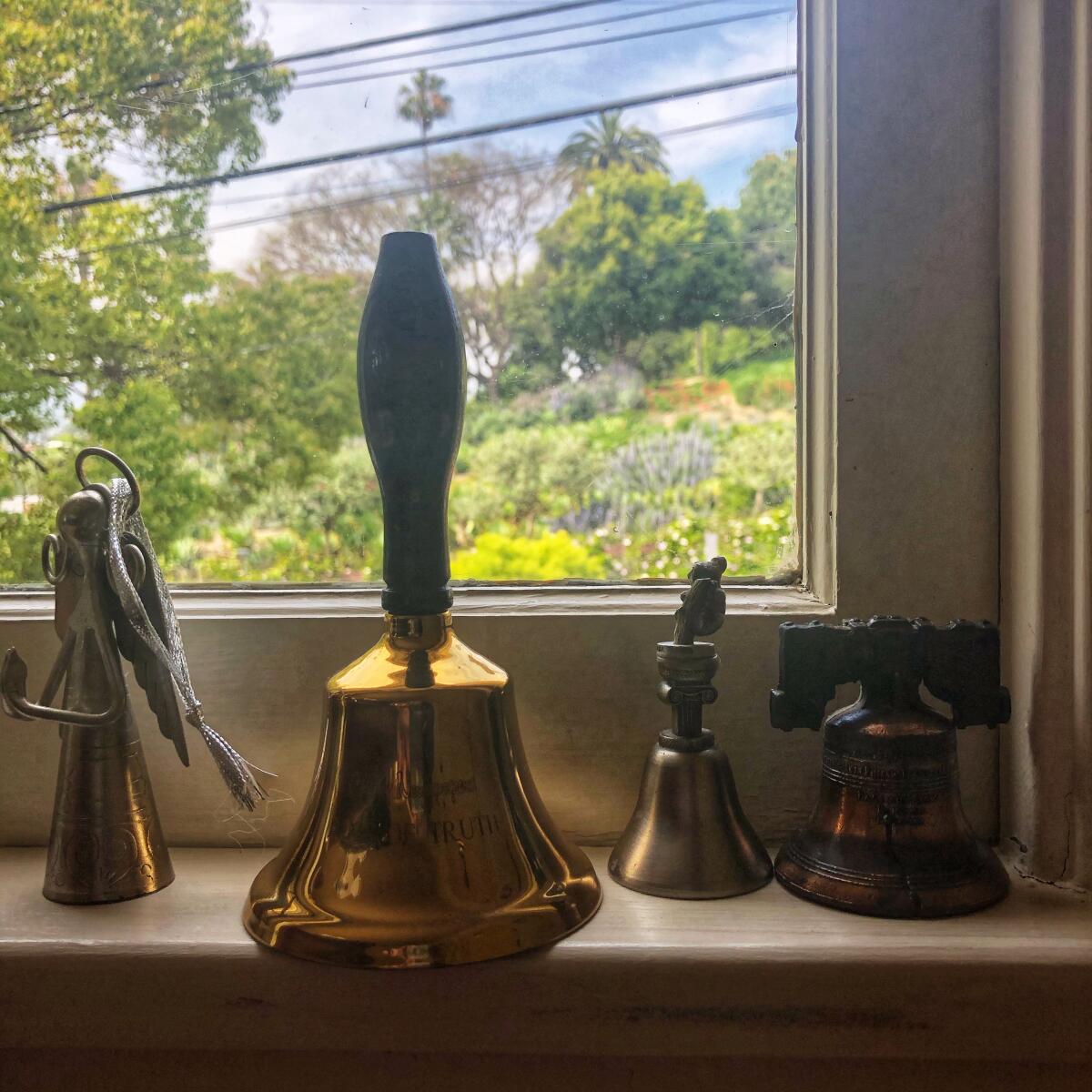
We live at the foot of a hill, within 1.2 miles of Children’s Hospital Los Angeles, Hollywood Presbyterian Medical Center and the big Kaiser medical complex on Sunset Boulevard. At least a few hospital workers live on the slopes above us and the flats below.
About 7:55 p.m. each night, my wife grabs one of the bells we keep by the front door and heads outside. I lug a guitar or a wonderfully resonant aluminum tub from the garage. Our teen daughter stands on the balcony, like Evita.
At 8, we rattle, thump and howl. Our neighbors A. and C. emerge from the front unit banging pots. K., from the back unit, shakes a spice jar. A. and E., a few doors up, egg us on from their balcony. Up and down the hill, unseen collaborators join and the sounds bounce like billiard balls after a strong break.
This lasts three minutes, just enough time to signal our gratitude to the hospital people and every other neighbor helping us get through this, to shed stress and shout out worry.
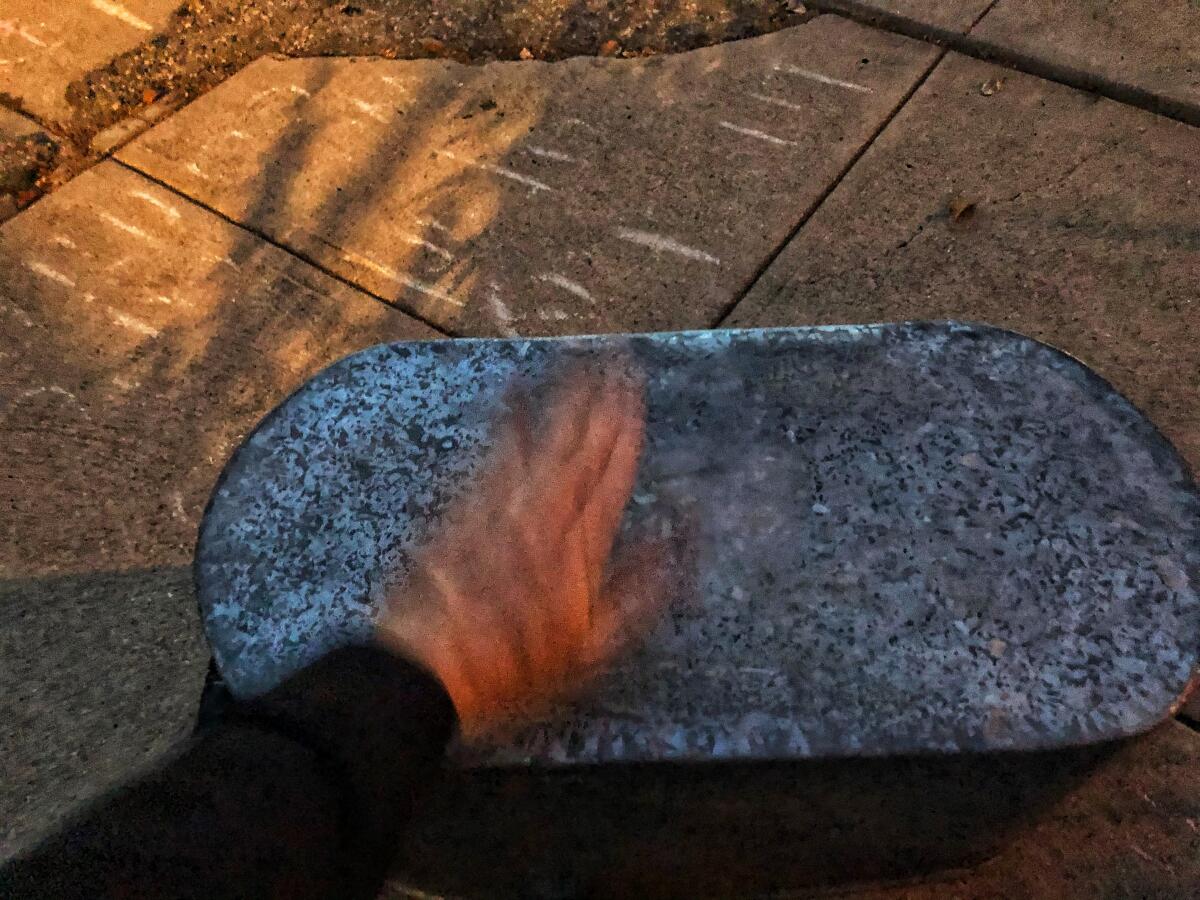
Since stress and worry aren’t leaving Los Angeles any time soon, I don’t think the noise-making should either. If I were sure I could get them to stop after three minutes, I’d recruit the morning leaf-blowers to join in too.
I do gather from NextDoor.com that one or two neighbors are cranky about all this. But they never say a word. Or at least I don’t hear them. The resonance on that tub is truly impressive.
— Christopher Reynolds
Sign up for The Wild
We’ll help you find the best places to hike, bike and run, as well as the perfect silent spots for meditation and yoga.
You may occasionally receive promotional content from the Los Angeles Times.